
Standard 35mm formats
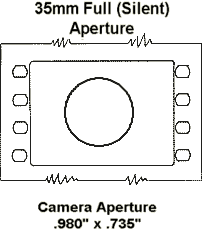
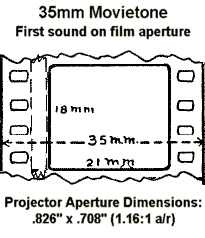
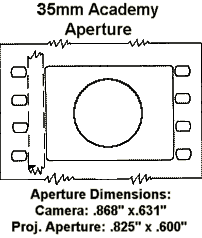
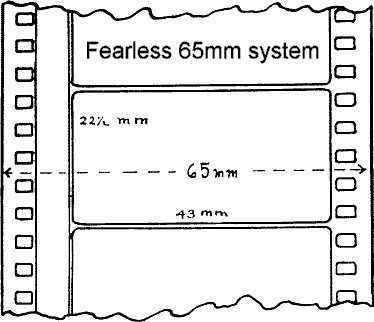
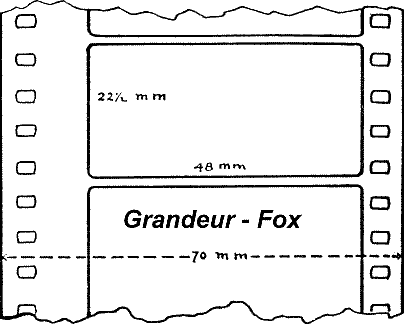
In 1929-1930, many of the studios attempted to break away from the confines of the nearly square 35mm format, made even more square with the addition of a sound track. Additionally, it was recognized that the 35mm frame was just too small to project optimally on the larger theatre screens. Since the studios owned their own theatre chains, consisting almost totally of very large palaces, they also developed a number of large format systems that they hoped would replace 35mm. Fox developed Grandeur, MGM had their Realife, Warner Bros. came out with Vitascope, and independent camera companies like Fearless and Mitchell developed their own systems. Film gauges ranged from about 56mm up to 70mm. With so many companies hot to go to large format film, one has to wonder why it died. The answer was that the studios wanted to avoid a battle, such as the one over sound formats that was finally nearing its end . They decided to wait and see which format would become a standard before they adopted one. But since there was no one championing their system any longer, the entire project faded away. Probably less than a dozen feature films were produced in wide gauges before it passed into never-never land. But not forever! As if fulfilling a prophesy, most of the old cameras were pulled off the warehouse shelves 25 years later and were converted to introduce Todd-AO, CinemaScope 55, and Ultra Panavision 70.
Cinerama 3-Strip System
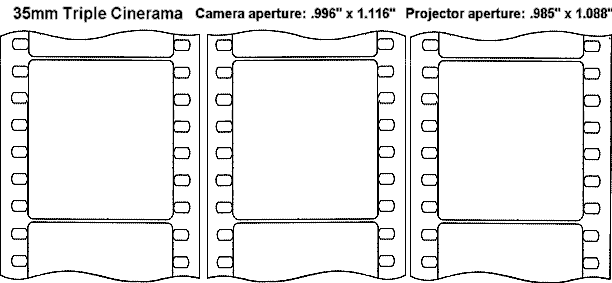
Cinerama, in 1952 not only introduced a wide image, it did so with three standard 35mm films using every bit of available image area in a six perforation high frame.
CinemaScope Compatible Anamorphic Systems
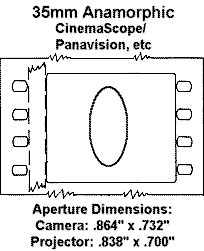
Twentieth Century-Fox's design for CinemaScope originally utilized the entire 35mm silent aperture, yielding a 2.66:1 image when projected. This was abandoned in favor of magnetic sound stripes on the film which slightly reduced the width of the image to 2.55:1. Nonstandard narrow perforations were developed to allow as much image area to be retained while providing adequate room for four magnetic tracks. Finally a further reduction in image width occurred with the development of the "magoptical" combination magnetic and optical sound print. The frame took on a 2.35:1 screen ratio with the addition of optical sound. Today the recommended projector aperture height has been reduced, to help cover splices, with the resulting ratio being 2.4:1. The small "Fox Hole" perforations were only used on magnetic prints.
VistaVision Horizontal System
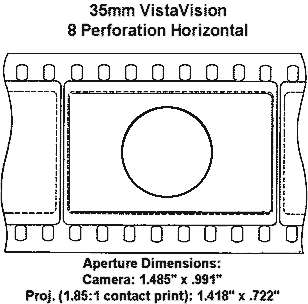
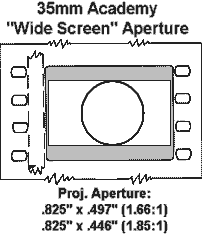
A few VistaVision films were contact printed to 8 perforation horizontal stock, but the vast majority of VistaVision films were shown in the Academy "Wide Screen" format using a tiny cropped portion of the available frame. Despite this, VistaVision prints were exceptionally good, thanks to the large format negative and the Technicolor processing and printing. In addition to the formats shown above, a few prints of White Christmas were also printed in a unique anamorphic format with a 1.5:1 squeeze. Superscope, Panavision, Hi-Lux and Gaumont variable anamorphic lenses were used for these prints. In Britain, Rank toyed with a 1.37x anamorphic print using the full Academy sound aperture to give a screen ratio of 1.85:1. Like Paramount's 1.5x anamorphic VistaVision, this was a short lived experiment.
Todd-AO & Super Panavision - 65/70mm Systems
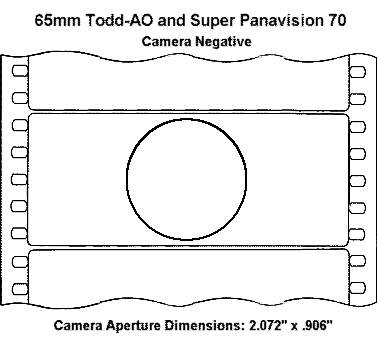
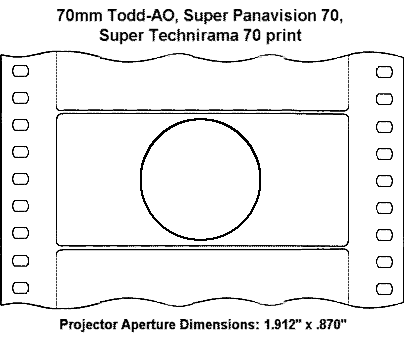
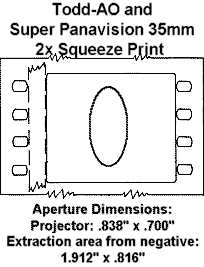
While the Todd-AO and Super Panavision 70 processes use a 65mm camera negative, the prints are made on 70mm stock to allow room for six magnetic sound tracks. Todd-AO's original frame rate of 30 fps didn't allow for the production of a CinemaScope compatible 35mm anamorphic print. After the first two films were made the speed was changed to the standard 24 fps. Optical anamorphic reduction prints of the 65mm negative are virtually identical to standard anamorphic films. Dimension 150, marketed by Todd-AO and 20th Century-Fox, shares specifications with Todd-AO and Super Panavision.
CinemaScope 55
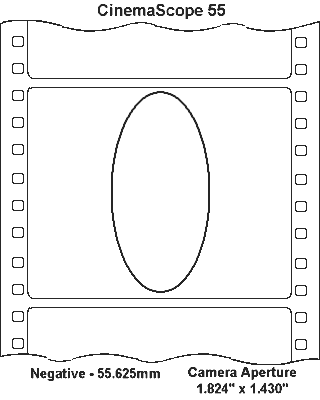

While CinemaScope had quickly acquired a strong following among most of the major studios, 20th Century-Fox management were not blind to the advantages of the large negative systems, VistaVision and Todd-AO. Skouras and Zanuck commissioned the development of a large format version of CinemaScope for use on prestige films and roadshow presentations. The result was CinemaScope 55, which used a negative 55.625mm in width and had a frame area exactly four times that of the 35mm version. The planned 55mm print including six track stereophonic sound never came to be. The two films produced in the process, Carousel, and The King and I, were both released in 35mm CinemaScope reduction prints.
Ultra Panavision 70 - Anamorphic 65/70mm System
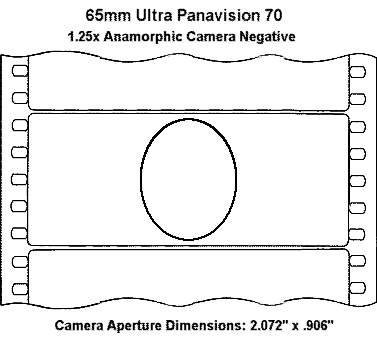
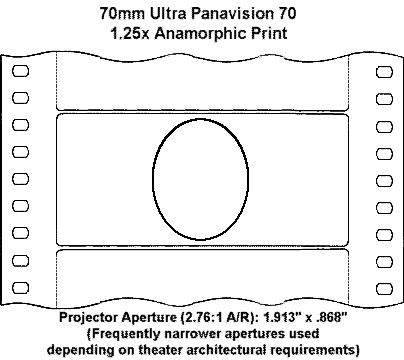
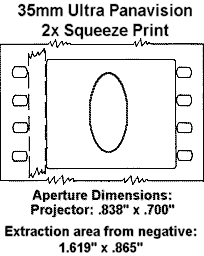
Ultra Panavision 70 (M-G-M Camera 65) used identical film stocks as Todd-AO for camera negative and prints. Only two films were shown using the anamorphic squeeze in the 70mm print. Even though the system could yield an image with a screen ratio of 2.76:1, generally projection was held to approximately 2.5:1. Other 70mm presentations were done with optical 70mm prints made with the compression eliminated or the quasi-Cinerama 70mm single film system (visit the Cinerama wing for more information). After Raintree County and Ben-Hur, which used 35mm prints made with letterbox type maskings at the top and bottom of the frame to create 2.5:1 aspect ratio within the frame area usually allotted to a 2.35:1 image, all other productions used 35mm anamorphic prints with dimensions compatible with CinemaScope.
Technirama Horizontal
Anamorphic System
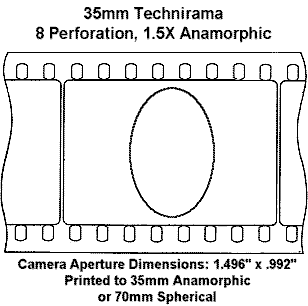
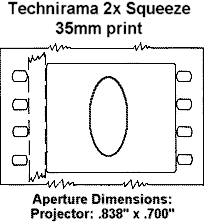

Technirama had been conceived of to provide both horizontal 8 perforation anamorphic prints and standard CinemaScope compatible prints. A few films were printed in 8 perf in Europe but the system was quickly abandoned as, like VistaVision, the conventional 35mm print proved to be exceptional. For large format presentations the system adopted a Todd-AO compatible optical 70mm print. The trade name Super Technirama 70 was applied to films destined for the 70mm blowup treatment. While Technirama used the same basic film format as VistaVision, it took advantage of nearly every available grain of film emulsion using both a far greater negative and print area. By 1960, Paramount announced that they would abandon VistaVision and adopt Technirama with it's more popular true wide screen ratio, but economics came into play and the studio simply abandoned VistaVision and used conventional flat photography or Panavision anamorphic, with only a few Technirama films actually making it into production.
Techniscope Anamorphic Blowup System
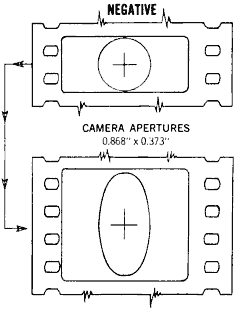
Techniscope was one of the few systems that never envisioned the use of a straight 1:1 print. The negative image was exactly one half the height of a CinemaScope frame and was photographed unsqueezed. Technicolor produced prints with a 2:1 vertical stretch creating a CinemaScope compatible release print.